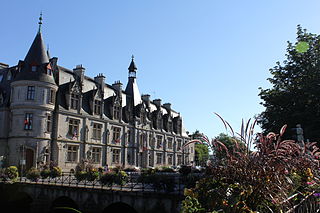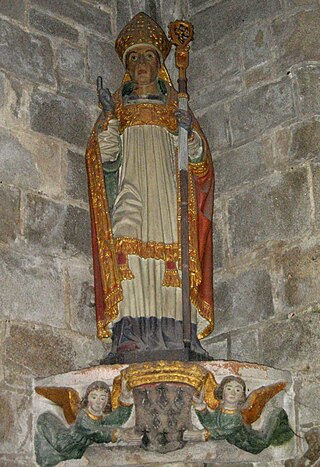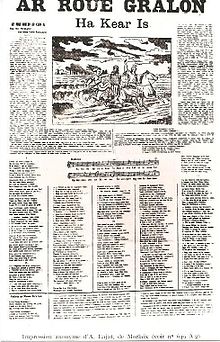
Finistère is a department of France in the extreme west of Brittany. Its prefecture is Quimper and its largest city is Brest. In 2019, it had a population of 915,090.

The Duchy of Brittany was a medieval feudal state that existed between approximately 939 and 1547. Its territory covered the northwestern peninsula of Europe, bordered by the Atlantic Ocean to the west, and the English Channel to the north. It was also less definitively bordered by the river Loire to the south, and Normandy, and other French provinces, to the east. The Duchy was established after the expulsion of Viking armies from the region around 939. The Duchy, in the 10th and 11th centuries, was politically unstable, with the dukes holding only limited power outside their own personal lands. The Duchy had mixed relationships with the neighbouring Duchy of Normandy, sometimes allying itself with Normandy, and at other times, such as the Breton–Norman War, entering into open conflict.

Ys, also spelled Is or Kêr-Is in Breton, and Ville d'Ys in French, is a mythical city on the coast of Brittany that was swallowed up by the ocean. Most versions of the legend place the city in the Baie de Douarnenez.

Quimper is a commune and prefecture of the Finistère department of Brittany in northwestern France.

Cornouaille is a historical region on the west coast of Brittany in West France. The name is cognate with Cornwall in neighbouring Great Britain. This can be explained by the settlement of Cornouaille by migrant princes from Cornwall who created an independent principality founded by Rivelen Mor Marthou, and the founding of the Bishopric of Cornouaille by ancient saints from Cornwall. Celtic Britons and the settlers in Brittany spoke a common language, which later evolved into Breton, Welsh and Cornish.

Mark of Cornwall was a sixth-century King of Kernow (Cornwall), possibly identical with King Conomor. He is best known for his appearance in Arthurian legend as the uncle of Tristan and the husband of Iseult who engages with Tristan in a secret liaison, giving Mark the epithet "Cuckold King".

Conan Meriadoc is a legendary British Celtic leader credited with founding Brittany. Versions of his story circulated in both Brittany and Great Britain from at least the early 12th century, and supplanted earlier legends of Brittany's foundation. His story is known in two major versions, which appear in the Welsh text known as The Dream of Macsen Wledig, and in Geoffrey of Monmouth's Historia Regum Britanniae. Both texts associate him with Magnus Maximus, a Roman usurper against the Valentinianic dynasty who was widely regarded as having deprived Britain of its defences when he took its legions to claim the imperial throne. Conan's cousin or sister, Saint Elen, is said to have been Macsen Wledic's wife.

Breton literature may refer to literature in the Breton language (Brezhoneg) or the broader literary tradition of Brittany in the three other main languages of the area, namely, Latin, Gallo and French – all of which have had strong mutual linguistic and cultural influences.

Dahut, also spelled Dahud, is a princess in Breton legend and literature, associated with the legend of the drowned city of Ys.

Le roi d'Ys is an opera in three acts and five tableaux by the French composer Édouard Lalo, to a libretto by Édouard Blau, based on the old Breton legend of the drowned city of Ys. That city was, according to the legend, the capital of the kingdom of Cornouaille.

Corentin of Quimper is a Breton saint. He was the first bishop of Quimper. Corentin was a hermit at Plomodiern and was regarded as one of the seven founding saints of Brittany. He is the patron saint of Cornouaille, Brittany, and is also the patron saint of seafood. His feast day is December 12.

Hawise of Rennes was Duchess of Brittany from 1066 until her death.

Saint Gwenhael was a Breton saint of the 6th century, born at Ergué-Gabéric (Finistère), the second abbot of Landévennec Abbey, successor in 532 to the founder, Saint Winwaloe (Gwenole). The feast of Saint Gwenaël is 3 November.

Saint Ronan was an Irish pilgrim saint and hermit in western Brittany. He was the eponymous founder of Locronan and co-patron of Quimper (France), together with its founder, Saint Corentin. He is also celebrated in the parish of Kilronan, Ireland
Alain Canhiart was the count of Cornouaille from 1020 to 1058. He was the son of Benoît de Cornouaille and the father of Hoël II, Duke of Brittany. His family name, Canhiart, is understood to be derived from the old Breton Kann Yac'h and was translated into the Latin texts of his era as Bellator fortis.

The Argol Parish close, including the Église Saint-Pierre et Saint-Paul, is located in Argol in the arrondissement of Châteaulin in Finistère in Brittany in north-western France. The parish church of Saint Peter and Saint Paul was built in 1575, restored in 1617 and enlarged in 1674. In 1784, the side walls were completely reconstructed as was the porch in 1839. The lintel of the belfry on the west gable of the church records the date 1582, Both the church and the "arc de triomphe" were listed as historical monument in 1914.. The church is also associated with Saint Geneviève who was nominated as the secondary patron in 1634. Records show that there was a priory run from the Benedictine abbey at Landévennec in the Middle Ages.
Morvarc'h is the name of a fabulous horse of Breton legend found in two folktales reworked in the 19th and 20th centuries. Though its name appears in older sources, it was invented or reinterpreted by Charles Guyot, who named it Morvark in his version of the legend of the city of Ys in 1926. It belongs to the "Queen of the North" Malgven, who gives it to her husband King Gradlon. Endowed with the ability to gallop on the waves, Morvarc'h is described as having a black coat and as breathing flames through its nostrils. It also appears in a Breton folktale about King Marc'h of Cornouaille. In the course of a deer hunt it is killed by its own rider's arrow, which has been turned around by the spell of Dahud, the daughter of Malgven. She then puts the ears of the horse Morvarc'h on the head of King Marc'h, who seeks in vain to hide them.
Malgven, or Malgwen(n), is a character introduced into the legend of the city of Ys, a mythical city on the coast of Brittany, at the end of the 19th century by Édouard Schuré, and is possibly based on a local legend from the Cap Sizun. She was made known by Charles Guyot (Géo-Charles) at the beginning of the 20th century, in his literary adaptation of the legend of Ys. As a valkyrie and queen of the "North", Malgven reigns over the land with her ageing husband, King Harold. She meets King Gradlon while he is raiding and falls in love with him. She persuades him to kill her husband and to flee with her on her horse Morvarc'h, towards Gradlon's lands in Brittany. The journey lasts a year, during which time she gives birth to a daughter, Dahut. Malgven dies in childbirth.















